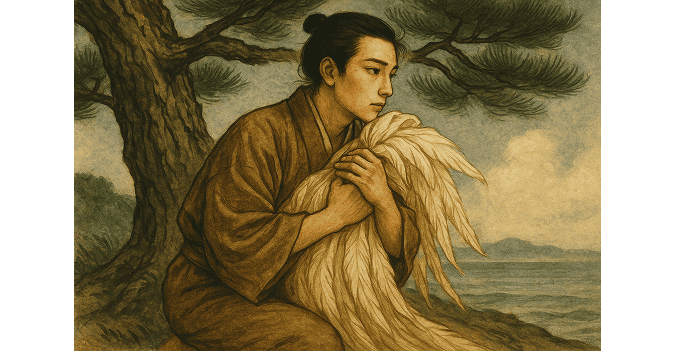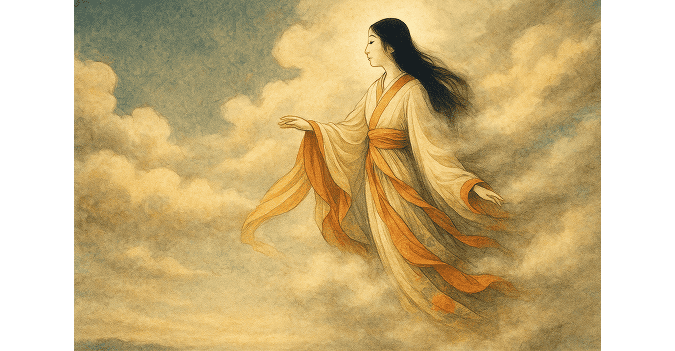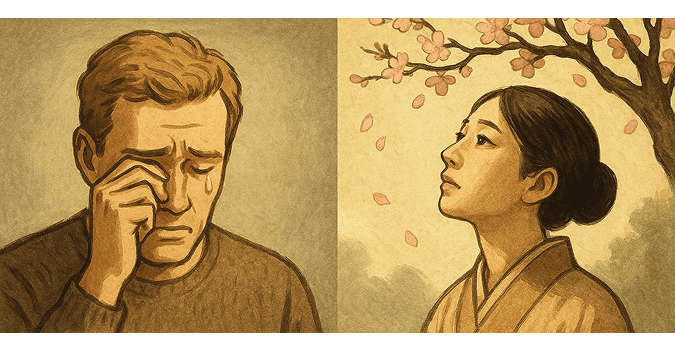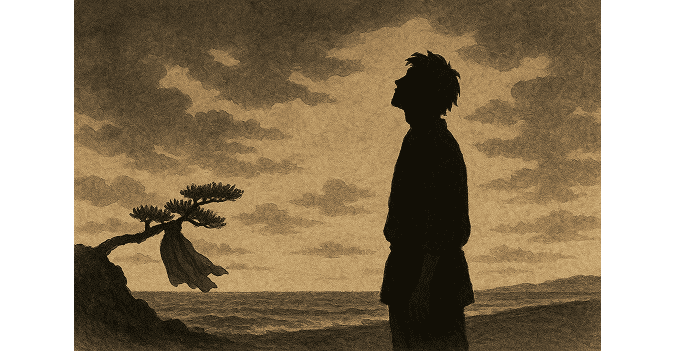The Legend of Hagoromo: Japan’s Beloved Story of the Celestial Maiden
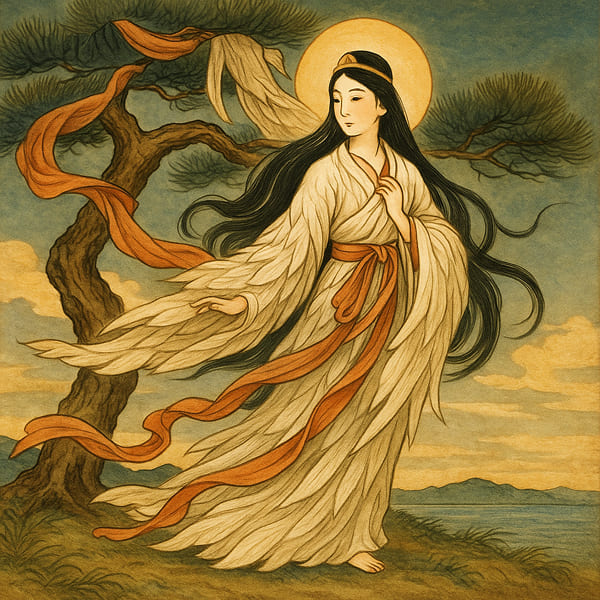
A stolen robe. A heavenly maiden forced to stay on earth. A love that could never last.
Imagine walking by the sea and finding a woman from the heavens—her feathered robe hanging on a pine tree, her future suddenly in your hands.
This is the Hagoromo legend, one of Japan’s most well-loved folktales. For hundreds of years, people in Japan have told this story in many ways. And even today, the legend lives on. You can find it in places like Miho no Matsubara, in Noh theater, and in modern anime and films.
What does the feathered robe really mean? Is it freedom? Is it love? Or is it the sadness of letting go?
Let’s explore the Hagoromo legend together—from its old beginnings to the many ways it is still told today.
The Story of the Feathered Robe
First, let’s take a look at the story of the Hagoromo legend.
People in Japan have told this legend for hundreds of years.
It begins like this…
Long ago, by the sea in Japan, a young man was walking near a quiet pine grove. The waves were gentle, and the air was still.
Then he saw something strange. A woman, shining with beauty, had come down from the heavens. She wore a robe made of feathers—a robe that gave her the power to fly back to the sky.
The maiden laid her robe over the branch of a pine tree. She stepped into the water to bathe, her figure reflected in the spring.
The young man watched, amazed. But as he looked, a thought grew inside him. He crept forward… and took the robe.
When the maiden came out of the water, she reached for her robe. It was gone. Without it, she could not return to the heavens. Tears filled her eyes. Just then, the young man stepped out and said kindly:
You look troubled. If you cannot go home, please come with me.
My house is nearby. Rest there until you find what you have lost.
The maiden had no choice. She followed him. In time, they lived together as husband and wife. They even had a child, and for a while, there was peace.
But one day, as she was cleaning the house, the maiden opened a chest. Inside was her feathered robe. She held it in her hands, silent. She looked once at her child, once at her husband. And then, without a word, she put on the robe.
Softly, she rose into the sky. Higher, and higher, until she disappeared into the clouds.
The man stood below, reaching out, but she was gone. And all that remained was the sound of the sea, and his eyes gazing upward— wondering if she still remembered him in the heavens.
This is the main story of Hagoromo, the Feathered Robe. But did you know that the Hagoromo legend is not just a single tale?Across Japan, people tell different versions of this story—each with its own place, characters, and ending.
In the next section, let’s explore these regional variations and discover the many faces of the feathered robe.
A small break — a little side note
Not just words on a page—why not imagine the Hagoromo legend through charming puppets instead?
This short puppet performance reimagines the Hagoromo legend of Miho no Matsubara in a fun and playful way.
With expressive puppets and dreamlike staging, the celestial maiden’s story becomes easy to picture and enjoy.
Best of all, there is no dialogue—so you can enjoy the movements and atmosphere without worrying about language.
It’s only a few minutes long—a light, creative way to experience Japan’s timeless folktale.
Variations Across Japan
The Hagoromo legend is not just one story. Across Japan, many regions tell their own version of the tale, each shaped by local beliefs and traditions.
Here are some of the most well-known versions, with their unique regional features:
| Region | Key Features |
|---|---|
| Miho no Matsubara (Shizuoka) | The most famous version. The maiden asks for her robe back, and in return she performs a divine dance before returning to the heavens. This version inspired the classic Noh play Hagoromo. |
| Tango (Kyoto) | Based on the Tango Fudoki. An old couple finds the robe, and the maiden becomes their adopted daughter. She never returns to the heavens but is honored as a local deity. |
| Tottori (Tottori) | The maiden marries a farmer and has children. When she regains her robe, she leaves. Her children try to call her back with music—giving names to local places. |
| Ryukyu Islands (Okinawa) | The maiden marries a man named Okuma Ooya. Their son is said to become King Satto, linking the legend directly to Ryukyuan royal history. |
Each of these stories keeps the same heart: a heavenly maiden, her feathered robe, and the moment of parting. But the details change—sometimes ending in reunion, sometimes in separation, and sometimes in worship.
Together, they show how the Hagoromo legend is not just a single tale, but a living tradition woven into the landscapes and histories of Japan.
Common Themes and Symbolism
At first, the Hagoromo story may seem like a simple tale of love and parting. But behind the beauty of the legend lie deeper themes—about freedom, desire, and the fragile balance between humans and the divine.
Here are some of the hidden meanings within the tale.
Let’s explore them together.
1. Desire and Deception
The act of hiding the feathered robe is not an act of romance. It is a loss of freedom for the maiden.
The man’s kindness hides a deception, showing how human desire can cross dangerous lines. In daily life, taking or hiding something that belongs to another person is clearly wrong. But the man is also moved by a very human feeling—being so amazed by beauty that he wants to keep it for himself.
This shows his human weakness: desire mixed with selfishness, and longing mixed with dishonesty. To see this more clearly, let’s compare the man on earth and the maiden from the heavens:
| The Man (Earth) | The Maiden (Heaven) |
|---|---|
| Acts from desire and selfishness | Symbol of purity and freedom |
| Hides the robe to keep her | Becomes trapped when the robe is gone |
| Wants to possess what he admires | Belongs to a world beyond human reach |
| Shows human weakness | Shows heavenly beauty |
This simple contrast shows us two sides: the weakness of humans and the purity of the heavens.
It reminds us that people, by nature, often desire what they cannot reach—and keep reaching, even when it can never truly be theirs.
2. The Inevitable Loss
Even if the couple lives in peace for a while, the ending is always the same: once the maiden finds her robe, she returns to the heavens. The man is left behind, holding nothing but memory.
In Japanese thought, this can be seen as a form of cause and effect (inga ōhō). Today, this phrase is often used when someone does something wrong and later faces the result—“you get what you deserve.”
In the story, the man hides the robe and lies to the maiden. As a result, the happiness he forced into existence is taken away.
What he tried to keep through deception is exactly what he loses in the end.
3. Mono no Aware: The Beauty of Sadness
At the heart of the legend is mono no aware (もののあはれ)—a key idea in Japanese thought. The phrase is difficult to translate directly, but it means the gentle sadness that comes from knowing everything is temporary.
It is the feeling you have when cherry blossoms are in full bloom—beautiful, but already beginning to fall. It is the ache of watching the sunset, knowing the light will soon fade. Rather than fighting this sadness, Japanese culture teaches us to see beauty inside it.
In the Hagoromo legend, the farewell is not a punishment. It is a reminder: not everything we love can stay with us. The story invites us not to judge, but simply to feel—the sorrow, and the fleeting beauty, together.
In the end, the Hagoromo legend shows us that even a short folktale can carry many hidden meanings.
It is a mirror of human weakness, sacred beauty, and the bittersweet truth that nothing lasts forever.
East and West: Different Ways of Seeing Sadness
For many Western readers, the Hagoromo legend may first feel like a tragic ending—a love story cut short, with no reunion or reward. A husband loses his wife, and nothing is resolved.
In Western culture, sadness is often seen as something negative—something to avoid, to heal, or to overcome. Stories may move toward redemption, victory, or a happy ending that erases sorrow.
| Western Perspective | Japanese Perspective |
|---|---|
| Sadness is a problem to be solved | Sadness is part of beauty |
| Stories end with redemption or reward | Stories end with acceptance and reflection |
| Aim is to overcome grief | Aim is to feel grief and see beauty in it |
In contrast, traditional Japanese culture often finds beauty within sadness itself. This way of thinking sees value in the fleeting moment, appreciating beauty even as it disappears.
To see beauty in the fleeting moment— this is the heart of mono no aware.
This does not mean that every Japanese person today lives by this idea in daily life. Rather, it is a way of thinking deeply rooted in Japanese literature, art, and cultural tradition—an aesthetic lens through which stories like Hagoromo have long been understood.
This difference is why the Hagoromo legend feels unique. Instead of offering punishment or reward, it leaves us with a quiet truth:
to love something is also to accept that it may one day be gone.
Similar Myths Around the World
The Hagoromo legend may feel uniquely Japanese, but similar stories appear across many cultures. Each tale speaks of a heavenly or magical woman, a stolen garment or feathers, and a parting that cannot be avoided.
Let’s take a look at some of these stories from around the world.
-
1. Europe – Swan Maidens
In European folktales, swan maidens remove their feathered cloaks to bathe. A man steals one cloak, and the maiden is forced to stay as his wife. They may have children and live together for a time, but once she finds the cloak, she flies away. In some versions, the man sets out on a long journey to try to bring her back.
-
2. China – The Weaver Girl and the Cowherd
A heavenly weaver falls in love with a mortal cowherd. Their love breaks the rules of heaven, and they are punished—separated across the stars. They can meet only once a year, on the seventh day of the seventh lunar month. This story later became the origin of the Tanabata Festival in Japan.
-
3. Southeast Asia – Bird Maidens
In folktales from the Philippines and Indonesia, a goddess or spirit takes the form of a bird. She removes her feathers to bathe, and a man hides them, making her his wife. Eventually she finds her feathers, returns to the heavens, and in some stories is later worshipped as a goddess.
Across cultures, the settings may be different, but the structure of the stories is strikingly similar. They all remind us of the same truth: love between heaven and earth is powerful—but never permanent.
Modern Interpretations
Did you know that the Hagoromo legend still inspires people today—in Japan and all around the world? Among the examples we’ll explore, you may even recognize some stories you already know. Let’s discover together how this ancient tale continues to live on in the modern world.
1. Traditional Stage Arts
One of the most famous interpretations is the classical Noh play Hagoromo, written around the 14th century. It is based on the best-known version of the legend from Miho no Matsubara, where the celestial maiden performs her dance before returning to the heavens.
Even today, this play is still performed, keeping the legend alive on Japan’s traditional stage.
A small break — a little side note
Would you like to see how the story of Hagoromo still lives today through Noh theater, Japan’s oldest performing art? With elegant chanting, minimalist movement, and symbolic costumes, this performance brings the celestial maiden’s tale to life on stage.
Don’t worry—even many Japanese people find Noh difficult to fully understand.
So you don’t need to watch it seriously or from start to finish.
Just enjoy the atmosphere for a few minutes, and let the mood of this living tradition reach you.
2. Global Stage and Dance
The story of a woman bound to earth by a hidden garment has inspired ballets, operas, and contemporary dance around the world. Similar motifs appear in works such as Swan Lake, where a magical woman is cursed and separated from love. These examples show that the themes of beauty, loss, and unreachable freedom are universal human feelings, appearing again and again in different parts of the world.
3. Anime, Manga, and Pop Culture
In modern Japan, echoes of Hagoromo can be found in anime, manga, and film. Stories often feature a celestial maiden, a magical robe, or the theme of a love divided between heaven and earth.
For example:
- Princess Serenity from Sailor Moon recalls the image of a moon maiden who falls in love with a man from Earth, yet their love is marked by fate.
- Studio Ghibli’s The Tale of the Princess Kaguya shares a similar theme of a heavenly being who must return to the sky, leaving sorrow behind.
Through these works, the legend takes on new forms—yet the heart remains the same: a fleeting encounter between heaven and earth, and the beauty and pain of letting go.
Conclusion: A Legend That Lingers
The Hagoromo legend is more than a story of love and loss. It is a glimpse of the unreachable, a reminder of the fragile line between heaven and earth.
We may never hold on to the divine. We may never understand why the things we love most must leave. And yet, like the man gazing at the empty sky, we cannot help but wonder— if somewhere, beyond the clouds, she still remembers us.
